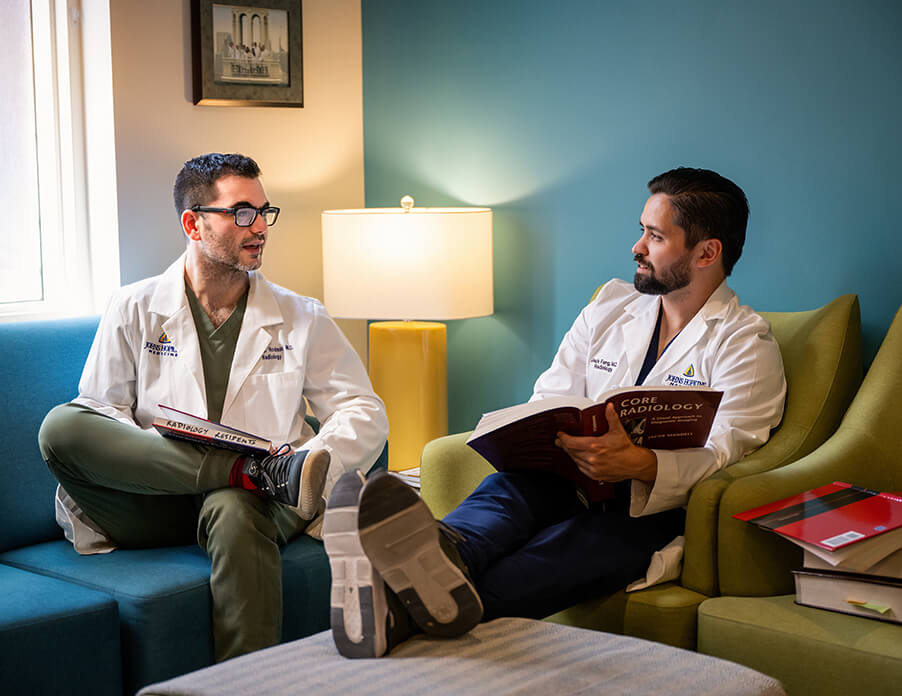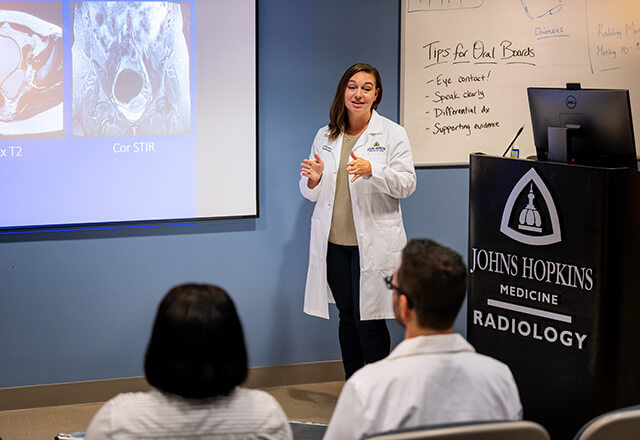Residents Prepare for Return of Oral Board Exams

Residents studying in the Johns Hopkins Hospital Resident Lounge
The ability to quickly analyze and interpret medical images is a critical skill that radiologists must develop during their training and hone throughout their careers.
In an effort to better assess residents’ readiness for the demands of clinical practice, the American Board of Radiology (ABR) has announced changes to the Diagnostic Radiology Certifying Exam, including the return of the oral DR Certifying Exam. Currently, the Certifying Exam is multiple choice.
The changes are slated to begin in 2028 and will first apply to residents completing training in June 2027. Trainees beginning residency July 1, 2023, will be the first class to participate in the new oral boards.
Currently, all residents take the Diagnostic Radiology CORE Exam and the Diagnostic Radiology Certifying Exam. According to Erin Gomez, program director of the diagnostic imaging and molecular imaging residencies, details are still forthcoming, but only the Diagnostic Radiology Certifying Exam will change. The CORE Exam will remain the same.
The CORE Exam is taken after 36 months of residency. The three-day, multiple-choice test is administered virtually.
Dave Gullotti is in his 5th year of post graduate training within the Johns Hopkins Integrated Diagnostic and Interventional Radiology Residency Program. He sat for his Core Exam this past spring. He will not take the new oral exam, since he will sit for his Certifying Exam prior to 2028.
According to Gullotti, the Core Exam includes more than 600 questions that cover a variety of specialties across radiology.
The Certifying Exam is taken about 18 months after completing residency. Currently, the test consists of a one-day, virtually administered, multiple-choice exam. This test was introduced several years ago, after the previous oral exam was phased out. Beginning in 2028, the multiple-choice Certifying Exam will be replaced with the new Diagnostic Radiology Oral Exam.
In years past, Gomez noted, residents had to travel to ABR headquarters in Kentucky to take the oral exam face to face. During the exam, residents would go from room to room, interpreting cases and answering questions asked by various in-person examiners.
The new Diagnostic Radiology Oral Exam will be virtual, though no less rigorous.
Using a secure proctoring software, residents will meet with examiners, who will present images and cases for the trainee to assess.
According to Gomez, the new oral exam should provide a more comprehensive assessment of trainees’ skills, especially in communication and working with colleagues.
“One thing that was diminished somewhat during the COVID pandemic is the ability to communicate with people effectively,” she said.
For Gullotti, the return of the oral exam format may benefit residents.
“The oral exam is likely more representative of the real world where thinking critically about differential diagnoses and conveying them clearly to other providers is more valued than a question with only one right answer” he noted.
 Erin Gomez lecturing in the Stoll Conference Room.
Erin Gomez lecturing in the Stoll Conference Room.
While Gomez noted that there is some work to do to prepare residents for the new oral exam format, she knows they will be ready.
The already-rigorous nature of Johns Hopkins’ diagnostic radiology residency means that residents will be well-prepared to share their skills in various formats, written or oral.
“We’re really lucky,” said Gomez, noting, “We have a very robust program for residents here.”
This consists of simulation labs that allow residents to practice with real-world equipment, as well as immersive experiences designed to mirror conditions such as overnight work. Similar experiences will likely be adapted to better prepare residents for the new Diagnostic Radiology Oral Exam.
Gomez is excited about the chance to share the talents of the residents and faculty of Johns Hopkins Radiology.
She concluded, “I think this is an opportunity for our program to show how great we can be.”
